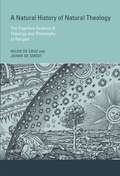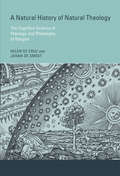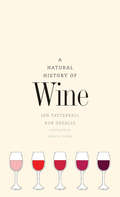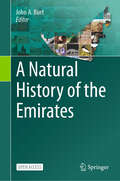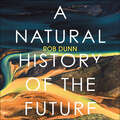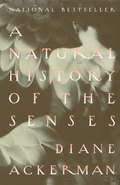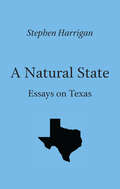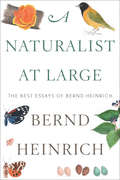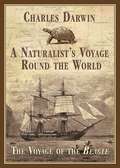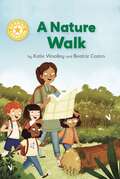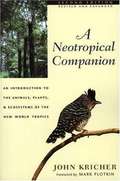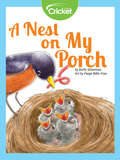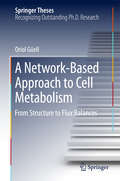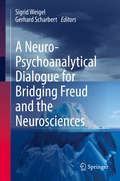- Table View
- List View
A Natural History of Color: The Science Behind What We See and How We See it
by Rob DeSalleA star curator at the American Museum of Natural History widens the palette and shows how the physical, natural, and cultural context of color are inextricably tied to what we see right before our eyes.Is color a phenomenon of science or a thing of art? Over the years, color has dazzled, enhanced, and clarified the world we see, embraced through the experimental palettes of painting, the advent of the color photograph, Technicolor pictures, color printing, on and on, a vivid and vibrant celebrated continuum. These turns to represent reality in &“living color&” echo our evolutionary reliance on and indeed privileging of color as a complex and vital form of consumption, classification, and creation. It&’s everywhere we look, yet do we really know much of anything about it? Finding color in stars and light, examining the system of classification that determines survival through natural selection, studying the arrival of color in our universe and as a fulcrum for philosophy, DeSalle&’s brilliant A Natural History of Color establishes that an understanding of color on many different levels is at the heart of learning about nature, neurobiology, individualism, even a philosophy of existence. Color and a fine tuned understanding of it is vital to understanding ourselves and our consciousness.
A Natural History of Families
by Scott ForbesWhy do baby sharks, hyenas, and pelicans kill their siblings? Why do beetles and mice commit infanticide? Why are twins and birth defects more common in older human mothers? A Natural History of Families concisely examines what behavioral ecologists have discovered about family dynamics and what these insights might tell us about human biology and behavior. Scott Forbes's engaging account describes an uneasy union among family members in which rivalry for resources often has dramatic and even fatal consequences. In nature, parents invest resources and control the allocation of resources among their offspring to perpetuate their genetic lineage. Those families sometimes function as cooperative units, the nepotistic and loving havens we choose to identify with. In the natural world, however, dysfunctional familial behavior is disarmingly commonplace. While explaining why infanticide, fratricide, and other seemingly antisocial behaviors are necessary, Forbes also uncovers several surprising applications to humans. Here the conflict begins in the moments following conception as embryos struggle to wrest control of pregnancy from the mother, and to wring more nourishment from her than she can spare, thus triggering morning sickness, diabetes, and high blood pressure. Mothers, in return, often spontaneously abort embryos with severe genetic defects, allowing for prenatal quality control of offspring. Using a broad sweep of entertaining examples culled from the world of animals and humans, A Natural History of Families is a lively introduction to the behavioral ecology of the family.
A Natural History of Human Morality
by Michael TomaselloMichael Tomasello offers the most detailed account to date of the evolution of human moral psychology. Based on experimental data comparing great apes and human children, he reconstructs two key evolutionary steps whereby early humans gradually became an ultra-cooperative and, eventually, a moral species capable of acting as a plural agent "we".
A Natural History of Human Thinking
by Michael TomaselloTool-making or culture, language or religious belief: ever since Darwin, thinkers have struggled to identify what fundamentally differentiates human beings from other animals. In this much-anticipated book, Michael Tomasello weaves his twenty years of comparative studies of humans and great apes into a compelling argument that cooperative social interaction is the key to our cognitive uniqueness. Once our ancestors learned to put their heads together with others to pursue shared goals, humankind was on an evolutionary path all its own. Tomasello argues that our prehuman ancestors, like todays great apes, were social beings who could solve problems by thinking. But they were almost entirely competitive, aiming only at their individual goals. As ecological changes forced them into more cooperative living arrangements, early humans had to coordinate their actions and communicate their thoughts with collaborative partners. Tomasellos "shared intentionality hypothesis" captures how these more socially complex forms of life led to more conceptually complex forms of thinking. In order to survive, humans had to learn to see the world from multiple social perspectives, to draw socially recursive inferences, and to monitor their own thinking via the normative standards of the group. Even language and culture arose from the preexisting need to work together. What differentiates us most from other great apes, Tomasello proposes, are the new forms of thinking engendered by our new forms of collaborative and communicative interaction. "A Natural History of Human Thinking "is the most detailed scientific analysis to date of the connection between human sociality and cognition.
A Natural History of Natural Theology
by Johan De Smedt Helen De CruzQuestions about the existence and attributes of God form the subject matter of natural theology, which seeks to gain knowledge of the divine by relying on reason and experience of the world. Arguments in natural theology rely largely on intuitions and inferences that seem natural to us, occurring spontaneously -- at the sight of a beautiful landscape, perhaps, or in wonderment at the complexity of the cosmos -- even to a nonphilosopher. In this book, Helen De Cruz and Johan De Smedt examine the cognitive origins of arguments in natural theology. They find that although natural theological arguments can be very sophisticated, they are rooted in everyday intuitions about purpose, causation, agency, and morality. Using evidence and theories from disciplines including the cognitive science of religion, evolutionary ethics, evolutionary aesthetics, and the cognitive science of testimony, they show that these intuitions emerge early in development and are a stable part of human cognition.De Cruz and De Smedt analyze the cognitive underpinnings of five well-known arguments for the existence of God: the argument from design, the cosmological argument, the moral argument, the argument from beauty, and the argument from miracles. Finally, they consider whether the cognitive origins of these natural theological arguments should affect their rationality.
A Natural History of Natural Theology: The Cognitive Science of Theology and Philosophy of Religion (The\mit Press Ser.)
by Johan De Smedt Helen De CruzAn examination of the cognitive foundations of intuitions about the existence and attributes of God.Questions about the existence and attributes of God form the subject matter of natural theology, which seeks to gain knowledge of the divine by relying on reason and experience of the world. Arguments in natural theology rely largely on intuitions and inferences that seem natural to us, occurring spontaneously—at the sight of a beautiful landscape, perhaps, or in wonderment at the complexity of the cosmos—even to a nonphilosopher. In this book, Helen De Cruz and Johan De Smedt examine the cognitive origins of arguments in natural theology. They find that although natural theological arguments can be very sophisticated, they are rooted in everyday intuitions about purpose, causation, agency, and morality. Using evidence and theories from disciplines including the cognitive science of religion, evolutionary ethics, evolutionary aesthetics, and the cognitive science of testimony, they show that these intuitions emerge early in development and are a stable part of human cognition.De Cruz and De Smedt analyze the cognitive underpinnings of five well-known arguments for the existence of God: the argument from design, the cosmological argument, the moral argument, the argument from beauty, and the argument from miracles. Finally, they consider whether the cognitive origins of these natural theological arguments should affect their rationality.
A Natural History of Shells (Princeton Science Library #124)
by Geerat J. VermeijFrom “one of the master naturalists of our time” (American Scientist), a fascinating exploration of what seashells reveal about biology, evolution, and the history of lifeGeerat Vermeij wrote this “celebration of shells” to share his enthusiasm for these supremely elegant creations and what they can teach us about nature. Most popular books on shells emphasize the identification of species, but Vermeij uses shells as a way to explore major ideas in biology. How are shells built? How do they work? And how did they evolve? With lucidity and charm, the MacArthur-winning evolutionary biologist reveals how shells give us insights into the lives of animals today and in the distant geological past.
A Natural History of Trail Ridge Road: Rocky Mountain National Park's Highway to the Sky (Natural History)
by Amy LawConstructed from 1929 to 1932 and opened to tourists and drivers the following year, Trail Ridge Road earned immediate inclusion among the scenic wonders of the world. The new path through the park followed the ancient trail across Tombstone Ridge and offered visitors breathtaking views and a privileged glimpse at unique ecosystems. Today, Trail Ridge Road endures as a truly otherworldly place. It is the country's highest continuous paved road, peaking at over twelve thousand feet and running forty-eight miles. Join author Amy Law on a tour across the Continental Divide and through the history of Colorado's most famous byway.
A Natural History of Wine
by Ian Tattersall Rob DeSalle&“Wine is art. Wine is ritual. Wine is culture. Wine is romance. But in the hands of Tattersall and DeSalle . . . we learn that wine is also science.&”—Neil deGrasse Tyson A Wall Street Journal Best Book for Wine Lovers An excellent bottle of wine can be the spark that inspires a brainstorming session. Such was the case for Ian Tattersall and Rob DeSalle, scientists who frequently collaborate on book and museum exhibition projects. When the conversation turned to wine one evening, it almost inevitably led the two—one a palaeoanthropologist, the other a molecular biologist—to begin exploring the many intersections between science and wine. This book presents their fascinating, freewheeling answers to the question &“What can science tell us about wine?&” And vice versa. Conversational and accessible to everyone, this colorfully illustrated book embraces almost every imaginable area of the sciences, from microbiology and ecology (for an understanding of what creates this complex beverage) to physiology and neurobiology (for insight into the effects of wine on the mind and body). The authors draw on physics, chemistry, biochemistry, evolution, and climatology, and they expand the discussion to include insights from anthropology, primatology, entomology, Neolithic archaeology, and even classical history. The resulting volume is indispensable for anyone who wishes to appreciate wine to its fullest. &“Chemistry. Evolutionary biology. Genetics. This book is an excellent layman&’s refresher on these diverse topics, and many more, and how they fit into the grand scheme of wine . . . A fact-packed and accessible read that goes a long way toward explaining why and how wine became such an important component in our enjoyment of the natural world.&”—Wine Spectator
A Natural History of the Emirates
by John A. BurtFor many people, thoughts of the United Arab Emirates conjure images of ultramodern skyscrapers and rolling sand dunes. However, the Emirates are a rich mosaic of ecosystems and habitats that support surprisingly diverse communities of organisms, and there is growing awareness of the importance of these previously underappreciated natural assets. A Natural History of the Emirates provides a comprehensive overview of the unusual environmental setting of this young nation, and surveys the major ecosystems and the marine and terrestrial organisms occurring across the nation. From freshwater streams in the hyperarid Hajar Mountains to the world’s most temperature-tolerant coral reefs, the UAE is home to an astounding variety of uniquely adapted organisms that are providing insights into climate change and how organisms cope with and respond to extreme environmental conditions. The book closes with a section on human interactions with this unique environment, and proposes initiatives to ensure the protection of these unique natural assets into the future. This is an open access book.
A Natural History of the Future: What the Laws of Biology Tell Us About the Destiny of the Human Species
by Rob DunnOver the past century, our species has made unprecedented technological innovations with which we have sought to control nature. From river levees to enormous one-crop fields, we continue to try to reshape nature for our purposes - so much so it seems we may be in danger of destroying it.In A Natural History of the Future, biologist Rob Dunn argues that nothing could be further from the truth: rather than asking whether nature will survive us, better to ask whether we will survive nature. Despite our best - or worst - efforts to control the biological world, life has its own rules, and no amount of human tampering can rewrite them. Elucidating several fundamental laws of ecology, evolution, and biogeography, Dunn shows why life cannot be stopped. We sequester our crops on monocultured fields, only to find new life emerging to attack them. We dump toxic waste only to find microbes to colonize it. And even in the London Tube, we have seen a new species of mosquito emerge to take advantage of an apparently inhospitable habitat. Life will not be repressed by our best-laid plans. Instead, Dunn shows us a vision of the biological future and the challenges the next generations could face.A Natural History of the Future sets a new standard for understanding the diversity of life and our future as a species.
A Natural History of the Future: What the Laws of Biology Tell Us About the Destiny of the Human Species
by Rob DunnA leading ecologist argues that if humankind is to survive on a fragile planet, we must understand and obey its iron laws.Over the past century, our species has made unprecedented technological innovations with which we have sought to control nature. From river levees to enormous one-crop fields, we continue to try to reshape nature for our purposes - so much so it seems we may be in danger of destroying it.In A Natural History of the Future, biologist Rob Dunn argues that nothing could be further from the truth: rather than asking whether nature will survive us, better to ask whether we will survive nature. Despite our best - or worst - efforts to control the biological world, life has its own rules, and no amount of human tampering can rewrite them. Elucidating several fundamental laws of ecology, evolution, and biogeography, Dunn shows why life cannot be stopped. We sequester our crops on monocultured fields, only to find new life emerging to attack them. We dump toxic waste only to find microbes to colonize it. And even in the London Tube, we have seen a new species of mosquito emerge to take advantage of an apparently inhospitable habitat. Life will not be repressed by our best-laid plans. Instead, Dunn shows us a vision of the biological future and the challenges the next generations could face.A Natural History of the Future sets a new standard for understanding the diversity of life and our future as a species.(P) 2022 Hachette Audio
A Natural History of the Future: What the Laws of Biology Tell Us about the Destiny of the Human Species
by Rob DunnA leading ecologist argues that if humankind is to survive on a fragile planet, we must understand and obey its iron lawsOur species has amassed unprecedented knowledge of nature, which we have tried to use to seize control of life and bend the planet to our will. In A Natural History of the Future, biologist Rob Dunn argues that such efforts are futile. We may see ourselves as life&’s overlords, but we are instead at its mercy. In the evolution of antibiotic resistance, the power of natural selection to create biodiversity, and even the surprising life of the London Underground, Dunn finds laws of life that no human activity can annul. When we create artificial islands of crops, dump toxic waste, or build communities, we provide new materials for old laws to shape. Life&’s future flourishing is not in question. Ours is.As ambitious as Edward Wilson&’s Sociobiology and as timely as Elizabeth Kolbert&’s The Sixth Extinction, A Natural History of the Future sets a new standard for understanding the diversity and destiny of life itself.
A Natural History of the Senses (Argumentos Ser.)
by Diane AckermanDiane Ackerman's lusciously written grand tour of the realm of the senses includes conversations with an iceberg in Antarctica and a professional nose in New York, along with dissertations on kisses and tattoos, sadistic cuisine and the music played by the planet Earth. "Delightful ... gives the reader the richest possible feeling of the worlds the senses take in."--The New York Times.
A Natural State: Essays on Texas
by Stephen Harrigan&“The personal essay at its best. What Edward Abbey did for the desert Southwest and what E. B. White did for Maine, Harrigan has done for Texas.&” —Houston Chronicle In this remarkable collection of essays, Stephen Harrigan explores, with an unfailing depth of feeling, the human longing to feel at home in the world of nature. In vivid and convincing prose, he evokes the landscape of his home territory, Texas, and his own reactions, sometimes droll, sometimes haunted, to the extraordinary power of place that Texas projects. &“Like our best nature writers, he tells us not only what&’s out there, but connects it to our everyday lives . . . A Natural State is recommended reading not just for Texans but for all who would explore their connections to the natural world.&” —The Washington Post &“While &‘luminous&’ is not a word that you would think of in connection with the Lone Star State, that&’s what these pieces are . . . They are filled with poetry, wit, and delightfully offbeat observations.&” —The San Diego Union-Tribune &“Harrigan defty weaves fact, historical perspective, and personal experience into a tightly interlaced evocative fabric . . . By the end of the book, he brings the vast Texas landscape within grasp of even the most skeptical reader.&” —The Denver Post &“Harrigan&’s observations are not those of an academically trained naturalist but rather the fresh outlook of a city-bred tourist rejoicing in the exhilaration of discovery.&” —Booklist &“Though several of the essays display a strong ecological bent, the author is never shrill. He is an accomplished prose stylist who combines accurate research with an unerring eye for detail. Highly recommended.&” —Science
A Naturalist at Large: The Best Essays of Bernd Heinrich
by Bernd HeinrichSome of the world&’s greatest writings on birds, insects, trees, elephants, and more by a scientist who &“richly deserves the comparison to Thoreau&” (The Washington Post Book World). From one of the finest scientist/writers of our time comes an engaging record of a life spent in close observation of the natural world, one that has yielded &“marvelous, mind-altering&” (Los Angeles Times) insight and discoveries. In essays that span several decades, Heinrich finds himself at home in Maine, where he plays host to visitors from Europe (the cluster flies) and more welcome guests from Asia (ladybugs); and as far away as Botswana, where he unravels the far-reaching ecological consequences of elephants&’ bruising treatment of mopane trees. The many fascinating discoveries in Naturalist at Large include the maple sap harvesting habits of red squirrels, and the &“instant&” flower-opening in the yellow iris as a way of ensuring potent pollination. Heinrich turns to his great love, the ravens, some of them close companions for years, as he designs a unique experiment to tease out the fascinating parameters of raven intelligence. Finally, he asks &“Where does a biologist find hope?&” while delivering an answer that informs and inspires. Praise for Bernd Heinrich &“One of the finest naturalists of our time.&”—Edward O. Wilson &“[Heinrich&’s] ability to linger and simply be there for the moment when, for instance, an elderly spider descends from a silken strand to take the insect he offers her is the heart of his appeal.&”—The Wall Street Journal &“Passionate observations [that] superbly mix memoir and science.&”—The New York Times Book Review
A Naturalist's Voyage Round the World: The Voyage of the Beagle
by Charles DarwinWhen On the Origin of Species came out in 1859, it changed the understanding of life and was the foundation of evolutionary biology. All the material that he received for this book was from the famous expeditions he took on the Beagle during the 1830s. This is the story of that voyage.A Naturalist's Voyage Round the World follows Charles Darwin over his almost five-year journey around the world, in which he studied animals, plants, geology, and much more. From the tip of South America and the Galapagos Islands to Australia and Tahiti, Darwin set out to study geology, but ended up finding the information that would lead to his theory of evolution by natural selection.With the original images from Darwin's journal, A Naturalist's Voyage Round the World is an incredible look into the past at one of the most important documentations of a sea voyage ever. The information collected by Darwin changed our world, and now you can relive every moment in his own words and illustrations.
A Nature Walk: Independent Reading Yellow 3 Non-fiction (Reading Champion #515)
by Katie WoolleyThis story is part of Reading Champion, a series carefully linked to book bands to encourage independent reading skills, developed with Dr Sue Bodman and Glen Franklin of UCL Institute of Education (IOE)Reading Champion offers independent reading books for children to practise and reinforce their developing reading skills.Fantastic, original stories are accompanied by engaging artwork and a reading activity. Each book has been carefully graded so that it can be matched to a child's reading ability, encouraging reading for pleasure.
A Neotropical Companion: An Introduction to the Animals, Plants, and Ecosystems of the New World Tropics (2nd Edition, Revised and Expanded)
by John KricherA Neotropical Companion is an extraordinarily readable introduction to the American tropics, the lands of Central and South America, their remarkable rainforests and other ecosystems, and the creatures that live there. It is the most comprehensive one-volume guide to the Neotropics available today. Widely praised in its first edition, it remains a book of unparalleled value to tourists, students, and scientists alike. This second edition has been substantially revised and expanded to incorporate the abundance of new scientific information that has been produced since it was first published in 1989. Major additions have been made to every chapter, and new chapters have been added on Neotropical ecosystems, human ecology, and the effects of deforestation. Biodiversity and its preservation are discussed throughout the book, and Neotropical evolution is described in detail. This new edition offers all new drawings and photographs, many of them in color. As enthusiastic readers of the first edition will attest, this is a charming book. Wearing his learning lightly and writing with ease and humor, John Kricher presents the complexities of tropical ecology as accessible and nonintimidating. Kricher is so thoroughly knowledgeable and the book is so complete in its coverage that general readers and ecotourists will not need any other book to help them identify and understand the plants and animals, from birds to bugs, that they will encounter in their travels to the New World tropics. At the same time, it will fascinate armchair travelers and students who may get no closer to the Neotropics than this engagingly written book.
A Nest Full of Eggs
by Priscilla Belz Jenkins Lizzy RockwellLearn about birds and how they build their families.
A Nest Is Noisy
by Dianna Hutts AstonFrom the award-winning creators of An Egg Is Quiet, A Seed Is Sleepy, A Butterfly Is Patient, and A Rock Is Lively comes this gorgeous and informative look at the fascinating world of nests. From tiny bee hummingbird nests to orangutan nests high in the rainforest canopy, an incredible variety of nests are showcased here in all their splendor. Poetic in voice and elegant in design, this carefully researched book introduces children to a captivating array of nest facts and will spark the imaginations of children whether in a classroom reading circle or on a parent's lap. Plus, this is a fixed-format version of the book, which looks nearly identical to the print version.
A Nest on My Porch
by Buffy Silverman Paige Billin-FryeWhen two robins build a nest and start to raise a family on the porch, a young buy uses his nature notebook to record his observations. He gets to watch as the eggs hatch into nestlings, and the nestlings grow into fledglings! Do you have robins where you live?
A Network-Based Approach to Cell Metabolism
by Oriol GüellThis thesis uses a systems-level approach to study the cellular metabolism, unveiling new mechanisms and responses that were impossible to reach with traditional reductionists procedures. The results reported here have a potential application in areas like metabolic engineering and disease treatment. They could also be used in determining the accuracy of the gene essentiality of new genome-scale reconstructions.Different methods and techniques, within the contexts of Systems Biology and the field known as Complex Networks Analysis have been applied in this work to show different features of the robustness of metabolic networks. The specific issues addressed here range from pure topological aspects of the networks themselves to the balance of biochemical fluxes.
A Neural Network Approach to Fluid Quantity Measurement in Dynamic Environments
by Edin Terzic Romesh Nagarajah Muhammad Alamgir Jenny TerzicSloshing causes liquid to fluctuate, making accurate level readings difficult to obtain in dynamic environments. The measurement system described uses a single-tube capacitive sensor to obtain an instantaneous level reading of the fluid surface, thereby accurately determining the fluid quantity in the presence of slosh. A neural network based classification technique has been applied to predict the actual quantity of the fluid contained in a tank under sloshing conditions. In A neural network approach to fluid quantity measurement in dynamic environments, effects of temperature variations and contamination on the capacitive sensor are discussed, and the authors propose that these effects can also be eliminated with the proposed neural network based classification system. To examine the performance of the classification system, many field trials were carried out on a running vehicle at various tank volume levels that range from 5 L to 50 L. The effectiveness of signal enhancement on the neural network based signal classification system is also investigated. Results obtained from the investigation are compared with traditionally used statistical averaging methods, and proves that the neural network based measurement system can produce highly accurate fluid quantity measurements in a dynamic environment. Although in this case a capacitive sensor was used to demonstrate measurement system this methodology is valid for all types of electronic sensors. The approach demonstrated in A neural network approach to fluid quantity measurement in dynamic environments can be applied to a wide range of fluid quantity measurement applications in the automotive, naval and aviation industries to produce accurate fluid level readings. Students, lecturers, and experts will find the description of current research about accurate fluid level measurement in dynamic environments using neural network approach useful.
A Neuro-Psychoanalytical Dialogue for Bridging Freud and the Neurosciences
by Sigrid Weigel Gerhard ScharbertThe book presents an overview of the term neuropsychoanalysis and traces its historical and scientific foundations as well as its cultural implications. It also turns its attention to some blind spots, open questions, and to what the future may hold. It examines the cooperative and conflicted relationship between psychoanalysis and neuroscience. Articles from different fields investigate the neurological basis of psychoanalysis as well as the psychological terms of neurology. They also discuss what psychoanalysis has to offer neuroscience. In addition, the emerging neuro-psychoanalytical dialogue is enriched here by the voice of a culturally informed history of science. The book brings leading authorities on these topics into conversation with each other, creating an unprecedented opportunity to better understand the 'language' of the psyche. Specific concerns include the discussion of corporeality, how the body figures into psychoanalysis, the meaning of the unconscious in connection with dreams, unconscious fantasies, and the field of epigenetics. Following a historical perspective the book provides a re-reading of Freud's drive theory, exploring his concept of 'life' at the threshold of science and culture as well as the relationship between various representations, somatic states and the origin of drive. Overall, the book argues that if the different methodological approaches of psychoanalysis and neuroscience are acknowledged not only for their individual uniqueness but also as a dialectic, then the resulting epistemological and methodological dialogue might open up a fascinating body of neuropsychoanalytical knowledge.




